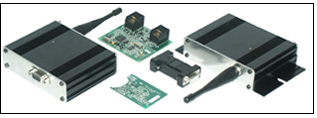The RFID division of Mannings, a company located in Southport, Merseyside, England, has launched a new system of RFID tags and readers that can monitor machines used in industrial and manufacturing plants.
The system features RFID two tag models—dubbed aTAG 1 and aTAG 2—with chips that can be configured to operate in any frequency ranging from 860 MHz to 920 MHz. The reader, which can accept signals from aTAG tags regardless of the chosen frequency, has a read range of up to 100 meters. Measuring 70mm by 64mm by 23mm in size, aTAG 1 has a total of 18 inputs (six analog and 12 digital) that can accept data from a variety of sensors; the smaller aTAG 2 has six (two analog and four digital).
Both tag models come with a temperature sensor, a battery, a battery-level sensor and a flash memory card that enables the configuration of the tag’s frequency and data transmission rate. The memory card also records the tag’s alarms settings for sending out alerts whenever a particular event happens. Battery life can last up to 10 years, depending on the signal and input frequency. The tags can also be wired to power source.
Each aTAG tag is identified by a unique algorithm that lets an aTAG reader pinpoint the tag’s location and, if the tag is moving, its direction of movement. The tag can by connected to temperature transducers, flow meters, pressure monitors, gas analyzers or other instruments that use 4 to 20 milliamp analog or digital I/O outputs. Once the reader receives the data transmitted by the tag, the data can be relayed to a PC or plant monitoring system using a standard RS232 cable.
Mannings and its partner, Handels Ock Konsulthuset Plefo AB, a company in Sweden, say the aTAG system can be integrated into existing building management systems, supervisory control and data acquisition (SCADA) software systems, or other monitoring software and is also compatible with wireless technology from Bluetooth. SCADA systems are used to monitor and control plant operations or equipment by collecting real-time data, such as where a leak on a pipeline has occurred, and transferring the data to a central repository.
Mono Pumps Ltd., a maker of cavity pumps, macerators, screens and grinders for industrial plants, is using the tags during installations of its products at customer sites. “RF tagging with 4 to 20mA sensory input allows Mono Pumps to monitor an installation without influence or interference with the clients’ systems while utilizing existing SCADA equipment,” says Gareth Thomas, an executive at Mono Pumps. “An engineer can see what he needs to see with minimal authorization and training or access to an end user’s systems,” he says. Mono Pumps isn’t monitoring every pump that it installs, but the company says by installing the tags on its pumps at a customer’s request, it is able to spot a problem faster and respond in a more effective manner.
The aTAG readers and tags cost £40 to £180 (US$72 to US$324) each.
Attend RFID Journal Live! 2004
Executive Conference, Chicago, March 29 to 31
It’s Where RFID Is Happening
Register Today


